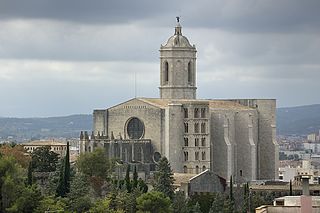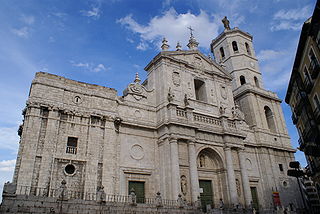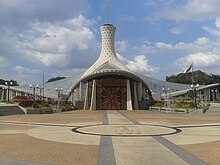
The Cathedral of the Holy Cross and Saint Eulalia, also known as Barcelona Cathedral, is the Gothic cathedral and seat of the Archbishop of Barcelona, Catalonia, Spain. The cathedral was constructed from the thirteenth to fifteenth centuries, with the principal work done in the fourteenth century. The cloister, which encloses the Well of the Geese was completed in 1448. In the late nineteenth century, the neo-Gothic façade was constructed over the nondescript exterior that was common to Catalan churches. The roof is notable for its gargoyles, featuring a wide range of animals, both domestic and mythical.

The Mosque–Cathedral of Córdoba, officially known by its ecclesiastical name, the Cathedral of Our Lady of the Assumption, is the cathedral of the Roman Catholic Diocese of Córdoba dedicated to the Assumption of Mary and located in the Spanish region of Andalusia. Due to its status as a former Islamic mosque, it is also known as the Mezquita and as the Great Mosque of Córdoba.

The Basilica Cathedral of Lima, otherwise Lima Cathedral, is a Roman Catholic cathedral located in the Plaza Mayor of downtown Lima, Peru. Construction began in 1535 and completed in 1649. It is dedicated to St John, Apostle and Evangelist.

The Basilica Cathedral of Arequipa is located in the "Plaza de Armas" of the city of Arequipa, province of Arequipa, Peru. It is the most important Catholic church of the city and also of the larger Roman Catholic Archdiocese of Arequipa since it is the base of the Archbishop and the Metropolitan Council. The cathedral is also considered one of Peru's most unusual and famous colonial cathedrals since the Spanish conquest.

The Cathedral of Saint Mary of the See, better known as Seville Cathedral, is a Roman Catholic cathedral in Seville, Andalusia, Spain. It was registered in 1987 by UNESCO as a World Heritage Site, along with the adjoining Alcázar palace complex and the General Archive of the Indies. It is the fourth-largest church in the world as well as the largest Gothic church.

The São Paulo Metropolitan Cathedral, also known as the See Cathedral, is the cathedral of the Roman Catholic Archdiocese of São Paulo, Brazil. Its current and seventh Metropolitan Archbishop is Dom Odilo Pedro Cardinal Scherer, appointed by Pope Benedict XVI on March 21, 2007, and installed on April 29 of the same year. The existing cathedral's construction, in a Gothic revival style, began in 1913 and ended four decades later. It was ready for its dedication on the 400th anniversary of the foundation of the then humble villa of São Paulo by Chief or Cacique Tibiriçá and the Jesuit priests Manuel da Nóbrega and José de Anchieta. Despite its Renaissance-style dome, the São Paulo Metropolitan Cathedral is considered by some to be the fourth largest neo-Gothic cathedral in the world.

Girona Cathedral, also known as the Cathedral of Saint Mary of Girona, is a Roman Catholic church located in Girona, Catalonia, Spain. It is the seat of the Roman Catholic Diocese of Girona. The cathedral's interior includes the widest Gothic nave in the world, with a width of 23 metres (75 ft), and the second-widest of any church after that of St. Peter's Basilica. Its construction was begun in the 11th century in the Romanesque architectural style, and continued in the 13th century in the Gothic style. Of the original Romanesque edifice only the 12th-century cloister and a bell tower remain. The second bell tower was completed in the 18th century.

The Metropolitan Cathedral of the Assumption of the Most Blessed Virgin Mary into Heaven is the cathedral church of the Roman Catholic Archdiocese of Mexico. It is situated atop the former Aztec sacred precinct near the Templo Mayor on the northern side of the Plaza de la Constitución (Zócalo) in the historic center of Mexico City. The cathedral was built in sections from 1573 to 1813, around the original church that was constructed soon after the Spanish conquest of Tenochtitlan, eventually replacing it entirely. Spanish architect Claudio de Arciniega planned the construction, drawing inspiration from Gothic cathedrals in Spain.

The Catedral de Nuestra Señora de Guadalupe is the cathedral for the Roman Catholic Diocese of Ponce located in downtown Ponce, Puerto Rico. The cathedral lies in the middle of Ponce's town square, known as Plaza Las Delicias, located at the center of the Ponce Historic Zone. For its historic significance, the cathedral was listed on the National Register of Historic Places in 1984. It is the seat of the Bishop of Ponce, currently Rubén González Medina.

The Caracas Cathedral or Metropolitan Cathedral of Saint Anne is the seat of the Roman Catholic Metropolitan archdiocese of Caracas, located on the Plaza Bolívar in Caracas, Venezuela. Its chapel of the Holy Trinity is the burial site of the parents and wife of Simón Bolívar. The Nuestra Senora de Venezuela y Santa Ana is a square (cuadra) situated between the cathedral and the central plaza, which is walled on three sides, but open to the east where it faces the cathedral.

The Guadalajara Cathedral or Cathedral of the Assumption of Our Lady, located in Centro, Guadalajara, Jalisco, is the Roman Catholic cathedral of the Archdiocese of Guadalajara and a minor basilica. It is built in the Spanish Renaissance style, except its Neo-gothic spires.

Saint Mary's Cathedral, better known as Lugo Cathedral, is a Roman Catholic church and basilica in Lugo, Galicia, north-western Spain. The cathedral was erected in the early 12th century in a Romanesque style, with Gothic, Baroque and Neoclassicist elements.

The Holy Cathedral of the Transfiguration of the Lord, also known as the Cathedral of Saint Mary of Huesca, is a Roman Catholic church in Huesca, in Aragon, north-eastern Spain. It is the seat of the Bishop of Huesca. Its architecture is Gothic, and its construction began in the late 13th century and was finished in the early 16th century.

The Metropolitan Cathedral of Saint John the Baptist of Badajoz is a Roman Catholic cathedral church in Badajoz, Extremadura, western Spain. Since 1994, together with the Co-cathedral of Saint Mary Major of Mérida, it is the seat of the Archdiocese of Mérida-Badajoz.

The Cathedral of Our Lady of the Holy Assumption, better known as Valladolid Cathedral, is a Roman Catholic church in Valladolid, Spain. The main layout was designed by Juan de Herrera in a Renaissance-style.

The Catedral Santiago Apostól , or in English, the Cathedral of St. James the Apostle, is a Catholic cathedral located on the town plaza in Fajardo, Puerto Rico. Along with Concatedral Dulce Nombre de Jesus in Humacao it is the seat of the Diocese of Fajardo-Humacao. It was listed on the National Register of Historic Places as Church Santiago Apóstol of Fajardo in 1984.

The Catedral de San Felipe Apóstol, or in English, Cathedral of St. Philip the Apostle, is a Catholic cathedral located in Arecibo, Puerto Rico. It is the seat of the Diocese of Arecibo.

Catedral de Nuestra Señora de La Asunción is the seat of the Roman Catholic Diocese of Margarita and is located in La Asunción, Nueva Esparta state, on Margarita Island, Venezuela. Completed in 1571, it is the oldest church in Venezuela.

Ourense Cathedral is a Roman Catholic church located in Ourense in northwestern Spain. Dedicated to St Martin, it was founded in 550. The first structure was restored by Alonso el Casto. The present mainly Gothic building was raised with the support of Bishop Lorenzo in 1220. Its local patroness is Saint Euphemia. There is a silver-plated shrine, and others of St Facundus and St Primitivus. The Christ's Chapel was added in 1567 by Bishop San Francisco Triccio. It contains an image of Christ, which was brought in 1330 from a small church on Cape Finisterre. John the Baptist's Chapel was created in 1468 by the Conde de Benavente. The Portal of Paradise is sculptured and enriched with figures of angels and saints, while the antique cloisters were erected in 1204 by Bishop Ederonio. The Capilla de la Maria Madre was restored in 1722, and connected by the cloisters with the cathedral. The eight canons were called Cardenales, as at the Cathedral of Santiago de Compostela, and they alone did services before the altar; this custom was recognised as "immemorial" by Pope Innocent III, in 1209. The cathedral, which has undergone an impressive transition of architectural styles of Romanesque, Gothic, Renaissance, Baroque and Neoclassical, was built to a Latin Cross plan. It has been a functional basilica since 1887. The cathedral has a crucifix that is held in great reverence all over Galicia.

Comodoro Rivadavia Cathedral is the cathedral church of Comodoro Rivadavia, Chubut Province, Argentina. It is situated at the intersection of Avenida Belgrano and Rivadavia. The cathedral is the city's main Roman Catholic church, serving the Diocese of Comodoro Rivadavia, part of the Archdiocese of Bahía Blanca. It was inaugurated by Bishop Moure Argimiro on November 26, 1978, and consecrated on June 9, 1979, by Monsignor Mariano Pérez, first Bishop of Comodoro Rivadavia. The building was constructed in Gothic-Modern style; some elements, such as a stained glass window, were brought from Turin, Italy, in 1959.





















